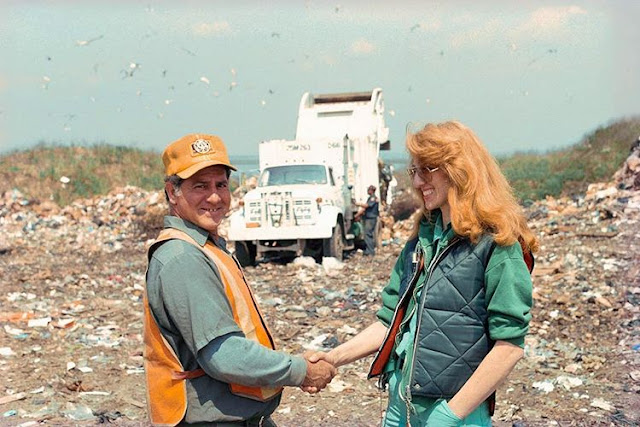Creative Placemaking and Relational Art
Mierle Laderman Ukeles is most known for her Touch Sanitation project. As the Artist in Residence for New York City’s Department of Sanitation, Ukeles created numerous maintenance related performances and installations. Touch Sanitation was a yearlong project in which she met and shook hands with more than 8,000 city sanitation workers. Documenting these encounters in photographs and texts, Ukeles thanked each employee “for keeping New York alive.” Through this systemic gesture, the artist drew attention to a crucial and neglected group of laborers and brought the art world into contact with urban ecology.
 Photograph by Vincent Russo “May 15, 1980, Sweep 10, Queens 14” From Touch Sanitation Performance, 1979 - 1980
Photograph by Vincent Russo “May 15, 1980, Sweep 10, Queens 14” From Touch Sanitation Performance, 1979 - 1980
 Photograph by Vincent Russo “May 15, 1980, Sweep 10, Queens 14” From Touch Sanitation Performance, 1979 - 1980
Photograph by Vincent Russo “May 15, 1980, Sweep 10, Queens 14” From Touch Sanitation Performance, 1979 - 1980
In a 1994 New York Times article, DOS Commissioner Emily Lloyd says of Ukeles,
"Her philosophy is my own...She’s saying, We have to understand that waste is an extension of ourselves and how we inhabit the planet, that sanitation workers are not untouchables that we don’t want to see. She advocates having our facilities be transparent and be visited as a way for people to be accountable for the waste they generate."
This succinctly sums up what Ukeles had set out to do. There was a conscious commitment not only on Ukeles part but the Commissioner's as well to focus not just on getting rid of the waste on NYC's streets, but to make an impact on the environment and think critically about how we dispose of trash and the human affect on the earth.
In shining a spotlight on the sanitation workers, Ukeles was doing something unquestionable political. Touch Sanitation used art to understand an existing system of maintenance, but what responsibilities do artists have when it comes to urban development and planning? Is it possible to thread the artist perspective into the fabric of municipalities?
When thinking about systemic changes necessary within communities and society, artists have a unique power to create change. By incorporating artists into urban planning and policy, not as an afterthought for beatification purposes, but as a necessary part of the development process, there can be an interesting shift in how municipalities create livable communities.
Comments
Post a Comment